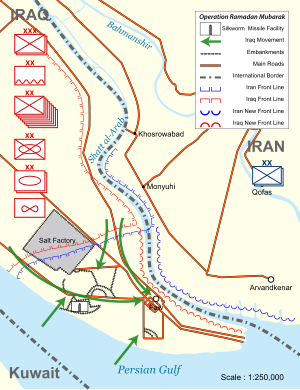
Back معركة تحرير الفاو Arabic ایکینجی الفاو دؤیوشو AZB Segunda Batalla de Al Fao Spanish نبرد دوم فاو Persian Seconda battaglia di al-Faw Italian 第2次アル=ファオの戦い Japanese Segunda Batalha de Al-Faw Portuguese
| Second Battle of al-Faw | |||||||||
|---|---|---|---|---|---|---|---|---|---|
| Part of Tawakalna ala Allah Operations of the Iran–Iraq War | |||||||||
 | |||||||||
| |||||||||
| Belligerents | |||||||||
|
|
| ||||||||
| Commanders and leaders | |||||||||
|
|
| ||||||||
| Strength | |||||||||
|
~100,000 Republican Guard soldiers[5] 1,200 tanks, 1,300 armored vehicles, 1,400 artillery pieces and 100 attack helicopters[1] |
20,000–40,000 Basij militia[5][1] 100 tanks and 150 artillery pieces[1] | ||||||||
| Casualties and losses | |||||||||
|
800 killed 20 armored vehicles lost[1] |
≈20,000 killed All remaining tanks and artillery pieces captured[1] | ||||||||
The Second Battle of al-Faw (also known as the Operation Ramadan Mubarak (Blessed Ramadan), fought on 17 April 1988, was a major battle of the Iran–Iraq War. After their defeat at the First Battle of al-Faw two years earlier, the newly restructured Iraqi Army conducted a major operation to clear the Iranians out of the peninsula.
The Iraqis concentrated well over 100,000 troops from the battle-hardened Republican Guard. The heavy use of chemical weapons quickly disarrayed the Iranian defenses,[6] which consisted of 15,000[7] Iranian Basij volunteers. The southern wing of the assault consisted of the Republican Guard's Madinah and Baghdad Divisions, which assaulted the Iranian lines and then allowed the Hammurabi Armoured Division to pass through and move along the southern coast of the peninsula and into al-Faw itself.
Meanwhile, the regular Iraqi Army's VII Corps attacked the northern end of the line with the 7th Infantry and 6th Armoured Divisions. While the 7th Infantry's attack became bogged down, the 6th Armoured broke through the Iranian lines, the 1st Mechanised Division pushed through, and later linked up with the Republican Guard divisions outside al-Faw. Thus the peninsula had been secured within thirty-five hours, with much of the Iranians' equipment captured intact.[7] The battle saw extensive use of chemical warfare by the Iraqis against the Iranians.
- ^ a b c d e f Razoux, Pierre (2015). The Iran-Iraq War. Harvard University Press, 2015. p. 440. ISBN 978-0674915718.
- ^ Pelletière, Stephen C. (30 March 1992). The Iran-Iraq War: Chaos in a Vacuum. Bloomsbury Academic. ISBN 9780275938437.
- ^ Pelletiere, Stephen C (10 December 1990). Lessons Learned: Iran-Iraq War. Marine Corps Historical Publication. p. 41.
- ^ Woods, Kevin M. (2011) [2010]. Saddam's Generals: Perspectives of the Iran-Iraq War. Alexandria, VA: Institute for Defense Analyses. p. 82. ISBN 9780160896132.
- ^ a b Ward, Steven (2009). Immortal: A Military History of Iran and Its Armed Forces. Georgetown University Press. p. 292. ISBN 978-1-58901-258-5.
- ^ Russell, Richard L. (2007). Weapons Proliferation and War in the Greater Middle East: Strategic Contest. Routledge. p. 44. ISBN 9781134213894.
- ^ a b Pollack, Kenneth Michael (2004). Arabs at War: Military Effectiveness, 1948–1991. Lincoln, NE: University of Nebraska Press. p. 225. ISBN 0-8032-8783-6.
© MMXXIII Rich X Search. We shall prevail. All rights reserved. Rich X Search